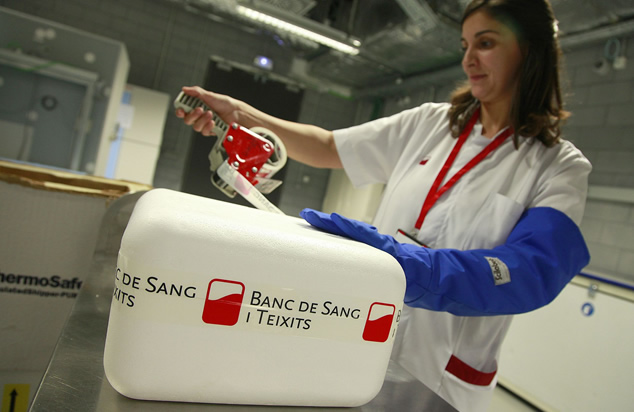The transfusion proces

What needs to be done before a transfusion?
- The nurse will prepare access to the patient's vein and check it for functionality and permeability. Blood component transfusions also need to be considered in the light of other treatments the patient may be receiving.
- Given that the transfusion may take several hours, we would advise patients to make themselves as comfortable as possible. They can eat and drink during the transfusion.
- It is advisable to monitor blood pressure, pulse and temperature before administering any blood product.
- Patients will be asked to tell the nurse about anything they may have noticed during the transfusion.
What steps are involved in a transfusion?
The steps which are followed during a transfusion are set out below:
Unequivocal identification of the recipient
Patients are asked for their name and surname. In cases when patients cannot answer, as in the case of anaesthetised or unconscious patients, identification is done by talking to family members and referring to the patient's clinical history. clínica
Check that the blood component we have is that which was prepared specifically for the patient
Checks are carried out to make sure that the recipient and the product label are correct and that they coincide. There are currently a number of options available (including bracelets and bar-code registration systems) that help to make sure recipients receive the correct product.
In the case of erythrocyte concentrate transfusions, the ABO group is checked
In the case of erythrocytes, it is advisable to check the ABO group both of the patient and as indicated on the bag at the head of the patient's bed.
Once the transfusion is underway the nurse will monitor the patient for a few minutes
The nurse will check for any reactions for several minutes after the transfusion has started.
How quickly should the transfusion be given?
Regardless of the component being transfused, the transfusion should be done slowly for the first few minutes. If there are no signs of a reaction, the speed can be adjusted to that recommended by the blood component.
Each blood component follows a different speed indicated on the table below. However, it should be emphasised that these recommendations are only valid provided that the recipient does not have a heart problem or is very elderly. In these cases, there is a greater possibility that the patient's body will show some signs of change which is why the transfusion is done more slowly.
| Blood Component | Average Volume | Duration of the Transfusion | Speed of the Transfusion |
|---|---|---|---|
| Erythrocytes | 200-300 ml | 60-120 min | 30-60 drops/minute |
| Plasma (Unitary or aphaeresis) | 200-600 ml | 20-60 min | 125-175 drops/minute |
| Platelets (mixtures 5 u/ aphaeresis) | 200-300 ml | 20-30 min | 125-225 drops/minute |
Why is it necessary to obtain consent before a transfusion?
A patient needs to be informed of the risks of a transfusion and of the therapeutic alternatives. After having been given this information the patient or, in the case of minors, their parent or guardian, can sign an INFORMED CONSENT TO RECEIVE BLOOD PRODUCTS form, which will be added to the patient's clinical history.
The absence of consent for blood component transfusions can cause problems. The law says that in the case of emergencies, doctors are required to administer treatment which they consider appropriate, even though this may be contrary to the wishes of the patient.
Jurisprudence considers the right to life, physical integrity and the protection of health, as absolute rights. The life of an individual is always above the autonomy of the individual.